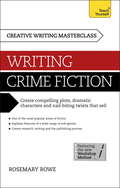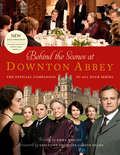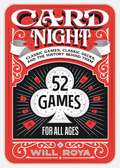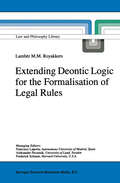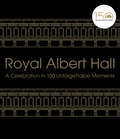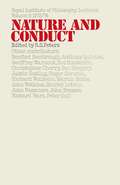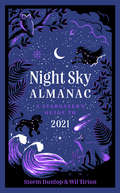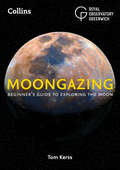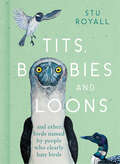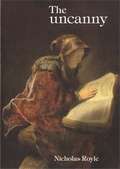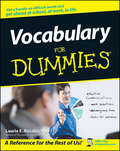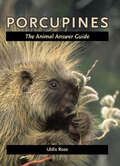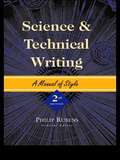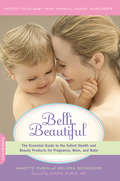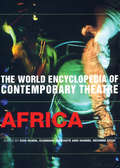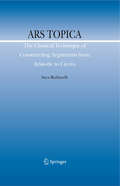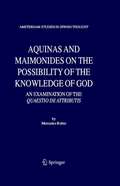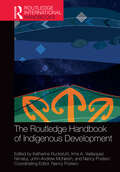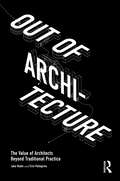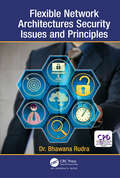- Table View
- List View
Masterclass: How to create compelling plots, dramatic characters and nail biting twists in crime and detective fiction
by Rosemary RoweDo you have an idea for a gripping crime novel?Would you like to know how to plot your book flawlessly?Do you want to create beautifully crafted characters and nail biting twists?This book is designed for anyone who wants to write an unputdownable crime novel. Whatever your subgenre, whether Scandi-crime or detective 'cosies', this book is full of inspirational advice, acute insights and practical exercises. The first part of the book establishes the rules of writing crime fiction - from convincing characters to the role of research. The book then covers the practical craft of writing and editing, before explaining in detail how to secure a contract and/or self-publish your work. A comprehensive guide for anyone who wants to be the next Val McDermid or Ian Rankin.
Behind the Scenes at Downton Abbey: The Official Companion To All Four Series
by Emma RowleyA revealing look backstage at the hit TV show Downton Abbey. In-depth interviews give an exclusive insight into the actors’ experiences on set as well as the celebrated creative team behind the award-winning drama.
Card Night: Classic Games, Classic Decks, and The History Behind Them
by Will RoyaLearn when to hold 'em and when to fold 'em with Card Night, a collection of 52 classic card games, including rules and strategies. Featuring step-by-step, illustrated instructions, and two indexes that organize each game by difficulty and number of players needed, Card Night includes directions for playing all the most popular card games, including Hearts and Bridge, Rummy and Go Fish. In addition to providing the rules of standard game play, Card Night also details the fascinating stories and peculiarities behind some of the world's most famous card decks, some of which were used as currency, tools for propaganda, and even as a means for sending coded messages. Offering one game for each week of the year, Card Night is the go-to companion for weekly game nights, long car rides, and rainy days spent at home. Wow your friends and family with your game playing prowess and keep them entertained with fascinating details from playing card history.
Extending Deontic Logic for the Formalisation of Legal Rules (Law and Philosophy Library #36)
by L.L. RoyakkersRoyal Albert Hall: A celebration in 150 unforgettable moments
by Royal Albert HallThe most iconic concert hall in the world celebrates 150 years with a stunning review of history's finest performances and performers. Opening with a personal letter from Queen Elizabeth II, this beautiful book celebrates 150 moments that have shaped The Royal Albert Hall over the last century and a half. From The Beatles to the Suffragettes, Albert Einstein to Winston Churchill, Mohammed Ali to B.B. King, few other buildings have housed such a stunning variety of era-defining people and events.This gorgeous, illustrated guide takes you behind the scenes of one of the most well-loved concert halls in the world, offering insights into the building’s iconic architecture, as well as its lesser-known quirks such as the reinforced toilets designed for Sumo wrestlers. This book features events ranging from the world's first sci-fi convention in 1891 to the annual Cirque du Soleil, which requires the auditorium to be transformed into a gymnasium. Autographs and candid comments from incredible performers who have appeared on its stage, like Russell Howard, Eric Clapton and Katie Derham, give a unique insider’s perspective on an esteemed and beloved British institution. With never-before-seen images, insights and more, this is the ultimate celebration of a British architectural icon which continues to inspire artists and audiences from around the world.
Night Sky Almanac 2021: A Stargazer's Guide
by Royal Observatory Greenwich Storm Dunlop Wil TirionThe perfect gift for amateur and seasoned astronomers. Follow the progress of constellations throughout the seasons with this beautiful companion to the night sky from Astronomy experts Collins.
Moongazing: Beginner's Guide To Exploring The Moon
by Royal Observatory Greenwich Tom KerssAn in-depth guide for aspiring astronomers and Moon observers. Includes detailed Moon maps and covers the history of lunar observation and exploration, the properties of the Moon, its origin and orbit. Optimised for colour tablets, the images in this ebook are not best-suited for viewing on black and white devices.
Tits, Boobies and Loons: And Others Birds Named By People Who Clearly Hate Birds
by Stu RoyallFrom the monotonous lark to the rough-faced shag, these poor birds have us all asking: ARE ORNITHOLOGISTS OK?
The Uncanny (PDF)
by Nicholas RoyleThis is the first book-length study of the uncanny, an important topic for contemporary thinking on literature, film, philosophy, psychoanalysis, feminism and queer history.
Vocabulary For Dummies (For Dummies Ser.)
by Laurie E. RozakisSomeone just called you captious. Should you be flattered? Considering your extreme lactose intolerance, is it a good idea to order veau au béchamel from a French menu? Calumny is to slander as obloquy is to a) flattery, b) sermon, or c) invective? You’ve just heard that your new boss is a real martinet, should you be worried or excited about an attractive new addition to your workplace? Your boyfriend says you have no élan, is he telling you you’re all out of yogurt? Starting to wish you’d paid more attention in English class? Don’t worry, it’s never too late to develop a million dollar vocabulary—and Vocabulary For Dummies offers you a fast, fun and easy way to do it. Whether you’re facing standardized tests, or you want to feel more knowledgeable at work or more comfortable in social situations, this book is for you. In no time you’ll: Dramatically expand your vocabulary Speak with style Write with panache Make a better impression a work or school Dine out with confidence Have the right words for formal occasions and ethnic events Get more out of what you read Vocabulary For Dummies doesn’t overwhelm you with endless word lists. Instead, it gives you a complete vocabulary-building program that familiarizes you with words from all areas of life as they’re used in context—from bar mitzvahs to business meetings, PCs to politics—with a host of fun features, including: Word tables organized by common features, such as language of origin, professional or social contexts, similarities, and more Sample conversations incorporate new terms and define related ones Before-and-After examples show how to replace old, general terms with new specific vocabulary Pointers reinforce understanding with examples of correct and incorrect usage Chapters on terms from finance, law, medicine, eating and shopping, history and mythology, various languages, and more Vocabulary For Dummies makes it easier than ever for you to get a handle on difficult words and get ahead at school, at work, and in life.
Porcupines: The Animal Answer Guide (The Animal Answer Guides: Q&A for the Curious Naturalist)
by Uldis RozeCould a porcupine make a good pet? Do they ever stick themselves or other porcupines with their quills? In this latest addition to the Animal Answer Guide series, we learn about these mysterious animals' "pincushion defense," along with the following facts:• Porcupines survive on a diet of leaves, bark, and fruit• Quills are actually modified hairs• There are 26 species of porcupines (and counting)• Old World and New World porcupines have a common ancestor but evolved independently• New World males will gather to fight ferociously over a single femalePorcupines: The Animal Answer Guide presents solid, current science in the field of porcupine biology. Uldis Roze compares and contrasts porcupines in terms of body plan, behavior, ecology, reproduction, and evolutionary relationships. He examines the diversity of porcupines from around the world—from North and South America to Africa and Asia.This guide explores the interactions between humans and porcupines, including hunting, use of quills by aboriginal societies, efforts to poison porcupines, and human and pet injuries (and deaths) caused by porcupines. Roze also highlights the conservation issues that surround some porcupine species, such as the thin-spine porcupine of Brazil, which is so rare that it was thought to be extinct until its rediscovery in the 1980s.
Porcupines: The Animal Answer Guide (The Animal Answer Guides: Q&A for the Curious Naturalist)
by Uldis RozeCould a porcupine make a good pet? Do they ever stick themselves or other porcupines with their quills? In this latest addition to the Animal Answer Guide series, we learn about these mysterious animals' "pincushion defense," along with the following facts:• Porcupines survive on a diet of leaves, bark, and fruit• Quills are actually modified hairs• There are 26 species of porcupines (and counting)• Old World and New World porcupines have a common ancestor but evolved independently• New World males will gather to fight ferociously over a single femalePorcupines: The Animal Answer Guide presents solid, current science in the field of porcupine biology. Uldis Roze compares and contrasts porcupines in terms of body plan, behavior, ecology, reproduction, and evolutionary relationships. He examines the diversity of porcupines from around the world—from North and South America to Africa and Asia.This guide explores the interactions between humans and porcupines, including hunting, use of quills by aboriginal societies, efforts to poison porcupines, and human and pet injuries (and deaths) caused by porcupines. Roze also highlights the conservation issues that surround some porcupine species, such as the thin-spine porcupine of Brazil, which is so rare that it was thought to be extinct until its rediscovery in the 1980s.
Science and Technical Writing: A Manual of Style
by Philip RubensWith this new edition, Science and Technical Writing confirms its position as the definitive style resource for thousands of established and aspiring technical writers. Editor Philip Rubens has fully revised and updated his popular 1992 edition, with full, authoritative coverage of the techniques and technologies that have revolutionized electronic communications over the past eight years.
Science and Technical Writing: A Manual of Style
by Philip RubensWith this new edition, Science and Technical Writing confirms its position as the definitive style resource for thousands of established and aspiring technical writers. Editor Philip Rubens has fully revised and updated his popular 1992 edition, with full, authoritative coverage of the techniques and technologies that have revolutionized electronic communications over the past eight years.
Belli Beautiful: The Essential Guide to the Safest Health and Beauty Products for Pregnancy, Mom, and Baby
by Annette Rubin Melissa SchweigerPregnant women are used to hearing the warnings from their ob-gyns about which foods and medications to avoid, but surprisingly no one informs them about which skin care ingredients could be potentially harmful to their unborn child through topical absorption. Many of the ingredients used in beauty products are normally safe, but when applied during pregnancy are actually linked to birth defects and miscarriage.Exposing the hidden pitfalls of the products we use every day, expert Annette Rubin-- founder of Belli Skincare, the #1 beauty brand recommended by ob-gyns--and beauty writer Melissa Schweiger show moms how to detoxify their skincare regimens. They explain the ingredients to watch for on labels and identify the safest products across major brands. But pregnancy and motherhood doesn&’t have to mean a ban on beauty! Packed with essential guidance, Belli Beautiful helps moms take the best care of their babies while still looking as fabulous as ever.
World Encyclopedia of Contemporary Theatre: Africa (World Encyclopedia Of Contemporary Theatre Ser.)
by Don Rubin Ousmane Diakhaté Hansel Ndumbe EyohNow available in paperback for the first time this edition of the World Encyclopedia of Contemporary Theatre series examines theatrical developments in Africa since 1945. Entries on thirty-two African countries are featured in this volume, preceded by specialist introductory essays on Anglophone Africa, Francophone Africa, History and Culture, Cosmology, Music, Dance, Theatre for Young Audiences and Puppetry. There are also special introductory general essays on African theatre written by Nobel Prize Laureate Wole Soyinka and the outstanding Congolese playwright, Sony Labou Tansi, before his untimely death in 1995. More up-to-date and more wide-ranging than any other publication, this is undoubtedly a major ground-breaking survey of contemporary African theatre.
Ars Topica: The Classical Technique of Constructing Arguments from Aristotle to Cicero (Argumentation Library #15)
by Sara RubinelliArs Topica is the first full-length study of the nature and development of topoi, the conceptual ancestors of modern argument schemes, between Aristotle and Cicero. Aristotle and Cicero configured topoi in a way that influenced the subsequent tradition. Their work on the topos-system grew out of an interest in creating a theory of argumentation which could stand between the rigour of formal logic and the emotive potential of rhetoric. This system went through a series of developments and transformations resulting from the interplay between the separate aims of gaining rhetorical effectiveness and of maintaining dialectical standards. Ars Topica presents a comprehensive treatment of Aristotle’s and Cicero’s methods of topoi and, by exploring their relationship, it illuminates an area of ancient rhetoric and logic which has been obscured for more than two thousand years. Through an interpretation which is philologically rooted in the historical context of topoi, the book lays the ground for evaluating the relevance of the classical approaches to modern research on arguments, and at the same time provides an introduction to Greek and Roman theory of argumentation focussed on its most important theoretical achievements.
Aquinas and Maimonides on the Possibility of the Knowledge of God: An Examination of The Quaestio de attributis (Amsterdam Studies in Jewish Philosophy #11)
by Mercedes RubioThis in-depth study of Thomas Aquinas’ Quaestio de Attributis binds together the findings of previous research on the unique history of this text by reconstructing the historical circumstances surrounding its composition, shows that the Quaestio contains Aquinas’ final answer to the dispute on the divine attributes, and thoroughly examines his interpretation of Maimonides’ position on the issue of the knowledge of God by analysing this and other texts related to it chronologically and doctrinally.
The Routledge Handbook of Indigenous Development (Routledge International Handbooks)
by Katharina Ruckstuhl Irma A. Velásquez Nimatuj John-Andrew McNeish Nancy PosteroThis Handbook inverts the lens on development, asking what Indigenous communities across the globe hope and build for themselves. In contrast to earlier writing on development, this volume focuses on Indigenous peoples as inspiring theorists and potent political actors who resist the ongoing destruction of their livelihoods. To foster their own visions of development, they look from the present back to Indigenous pasts and forward to Indigenous futures. Key questions: How do Indigenous theories of justice, sovereignty, and relations between humans and non-humans inform their understandings of development? How have Indigenous people used Rights of Nature, legal pluralism, and global governance systems to push for their visions? How do Indigenous relations with the Earth inform their struggles against natural resource extraction? How have native peoples negotiated the dangers and benefits of capitalism to foster their own life projects? How do Indigenous peoples in diaspora and in cities around the world contribute to Indigenous futures? How can Indigenous intellectuals, artists, and scientists control their intellectual property and knowledge systems and bring into being meaningful collective life projects? The book is intended for Indigenous and non-Indigenous activists, communities, scholars, and students. It provides a guide to current thinking across the disciplines that converge in the study of development, including geography, anthropology, environmental studies, development studies, political science, and Indigenous studies.
The Routledge Handbook of Indigenous Development (Routledge International Handbooks)
by Katharina Ruckstuhl Irma A. Velásquez Nimatuj John-Andrew McNeish Nancy PosteroThis Handbook inverts the lens on development, asking what Indigenous communities across the globe hope and build for themselves. In contrast to earlier writing on development, this volume focuses on Indigenous peoples as inspiring theorists and potent political actors who resist the ongoing destruction of their livelihoods. To foster their own visions of development, they look from the present back to Indigenous pasts and forward to Indigenous futures. Key questions: How do Indigenous theories of justice, sovereignty, and relations between humans and non-humans inform their understandings of development? How have Indigenous people used Rights of Nature, legal pluralism, and global governance systems to push for their visions? How do Indigenous relations with the Earth inform their struggles against natural resource extraction? How have native peoples negotiated the dangers and benefits of capitalism to foster their own life projects? How do Indigenous peoples in diaspora and in cities around the world contribute to Indigenous futures? How can Indigenous intellectuals, artists, and scientists control their intellectual property and knowledge systems and bring into being meaningful collective life projects? The book is intended for Indigenous and non-Indigenous activists, communities, scholars, and students. It provides a guide to current thinking across the disciplines that converge in the study of development, including geography, anthropology, environmental studies, development studies, political science, and Indigenous studies.
Out of Architecture: The Value of Architects Beyond Traditional Practice
by Jake Rudin Erin PellegrinoOut of Architecture is both a call to reassess the architecture profession and its education, and a toolkit for graduates and working architects to untangle their skills, passions, and value from traditional architectural practice and consider alternate pathways. Written by design professionals and expert career consultants, this book is informed by numerous client accounts as well as the authors’ own stories and routes out of architecture. The initial chapters follow the narrative of a typical architecture training in the US, highlighting the many highs and lows, skills honed, and ultimately the huge disconnect that can occur between architectural education and practice. Subsequent chapters explore a disillusionment with the profession, unhealthy work cultures, mentorship, working with lead architects, toxic perfectionism, and the notion of a “calling.” Authors then present the hopeful accounts of many architects who escaped a profession known for its grueling working conditions to find fulfilling, well-paying, creative jobs that better utilize the skills of architecture than the architectural profession itself. Written in a unique combination of storytelling and analysis, this patchwork of client and author stories makes for an immersive, provocative, and enjoyable read. A wide range of architecture students, graduates, educators, and professionals will recognize themselves within the pages of this book and find prompts to reassess their working practices, teaching styles, and the profession itself. It will be of particular value to those students skeptical of joining the architecture workforce, as well as those further along and considering a career change.
Out of Architecture: The Value of Architects Beyond Traditional Practice
by Jake Rudin Erin PellegrinoOut of Architecture is both a call to reassess the architecture profession and its education, and a toolkit for graduates and working architects to untangle their skills, passions, and value from traditional architectural practice and consider alternate pathways. Written by design professionals and expert career consultants, this book is informed by numerous client accounts as well as the authors’ own stories and routes out of architecture. The initial chapters follow the narrative of a typical architecture training in the US, highlighting the many highs and lows, skills honed, and ultimately the huge disconnect that can occur between architectural education and practice. Subsequent chapters explore a disillusionment with the profession, unhealthy work cultures, mentorship, working with lead architects, toxic perfectionism, and the notion of a “calling.” Authors then present the hopeful accounts of many architects who escaped a profession known for its grueling working conditions to find fulfilling, well-paying, creative jobs that better utilize the skills of architecture than the architectural profession itself. Written in a unique combination of storytelling and analysis, this patchwork of client and author stories makes for an immersive, provocative, and enjoyable read. A wide range of architecture students, graduates, educators, and professionals will recognize themselves within the pages of this book and find prompts to reassess their working practices, teaching styles, and the profession itself. It will be of particular value to those students skeptical of joining the architecture workforce, as well as those further along and considering a career change.
Flexible Network Architectures Security: Principles and Issues
by Bhawana RudraThe future of Internet security doesn’t lie in doing more of the same. It requires not only a new architecture, but the means of securing that architecture. Two trends have come together to make the topic of this book of vital interest. First, the explosive growth of the Internet connections for the exchange of information via networks increased the dependence of both organizations and individuals on the systems stored and communicated. This, in turn, has increased the awareness for the need to protect the data and add security as chief ingredient in the newly emerged architectures. Second, the disciplines of cryptography and network security have matured and are leading to the development of new techniques and protocols to enforce the network security in Future Internet. This book examines the new security architectures from organizations such as FIArch, GENI, and IETF and how they’ll contribute to a more secure Internet.
Flexible Network Architectures Security: Principles and Issues
by Bhawana RudraThe future of Internet security doesn’t lie in doing more of the same. It requires not only a new architecture, but the means of securing that architecture. Two trends have come together to make the topic of this book of vital interest. First, the explosive growth of the Internet connections for the exchange of information via networks increased the dependence of both organizations and individuals on the systems stored and communicated. This, in turn, has increased the awareness for the need to protect the data and add security as chief ingredient in the newly emerged architectures. Second, the disciplines of cryptography and network security have matured and are leading to the development of new techniques and protocols to enforce the network security in Future Internet. This book examines the new security architectures from organizations such as FIArch, GENI, and IETF and how they’ll contribute to a more secure Internet.
